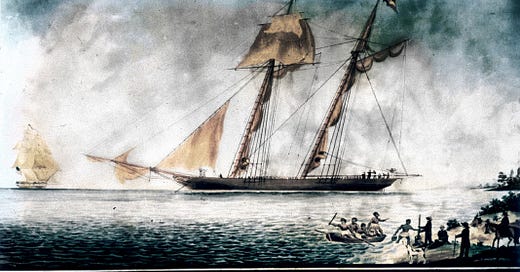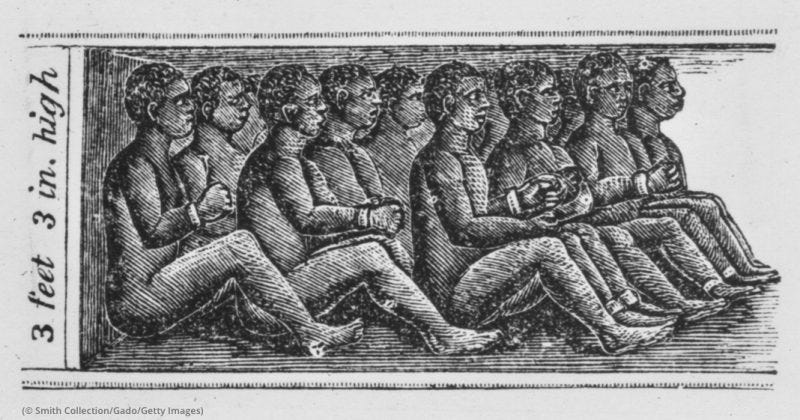The Amistad Rebellion (1839) – A Fight for Freedom on the High Seas
Black History Through the Lens of Liberation
How Enslaved Africans Took Their Liberation Into Their Own Hands
The story of the Amistad Rebellion is not just about resistance—it’s about Black people seizing their freedom in the face of unimaginable brutality. It’s a story that defies the whitewashed narratives of enslaved Africans as passive victims. In 1839, a group of enslaved Mende people from Sierra Leone rose up, took control of a slave ship, and fought for their right to return home. Their courage sparked an international legal battle that challenged the very foundations of slavery in the United States.
The Amistad rebellion reminds us that enslaved people never simply "waited" to be freed—they fought for their liberation at every turn, often at great personal cost. This event is one of many that prove Black resistance was an undeniable force long before the Civil War.
The Rebellion: How Enslaved Africans Took Over the Amistad
In June 1839, Portuguese slave traders illegally kidnapped a group of 53 Mende men, women, and children from Sierra Leone. They were shipped to Cuba, where they were fraudulently sold into slavery despite international laws banning the transatlantic slave trade.
From Havana, the captives were placed on La Amistad, a schooner bound for another part of Cuba. However, on July 1, 1839, in the middle of the night, the captives—led by Sengbe Pieh (Cinqué)—managed to break free of their chains using a nail and found weapons aboard the ship. Armed with machetes, they launched a violent but strategic uprising, killing the ship’s captain and cook while sparing the two Spaniards who had purchased them, José Ruiz and Pedro Montes.
Instead of killing the slavers outright, Cinqué and the rebels forced them to navigate the ship back to Africa. However, Ruiz and Montes secretly changed course at night, steering the Amistad northward into U.S. waters instead of toward Africa. After two months of drifting, the ship was seized by the U.S. Navy near Long Island, New York. The captives were immediately arrested and put on trial for mutiny and murder.
The Legal Battle: A Fight for Freedom in U.S. Courts
The Amistad case quickly became a landmark legal battle over the fate of the captives and, more broadly, the legality of the slave trade. The Spanish government demanded the return of the captives as "property," while abolitionists saw this as an opportunity to strike a blow against slavery.
The Trial’s Key Questions:
✔ Were the captives legally enslaved?
✔ Did they have the right to fight for their freedom?
✔ Should they be returned to Cuba as property or set free?
Abolitionists Take Action
The case gained national attention, and abolitionists rallied to defend the Mende rebels. They raised funds for their legal defense and argued that since the transatlantic slave trade was illegal, the captives were not "slaves" but free people who had the right to resist their unlawful enslavement.
Victory: The Supreme Court Rules in Favor of Freedom
The case went all the way to the U.S. Supreme Court in 1841. In a stunning ruling, the court decided in favor of the Amistad rebels, declaring that they had been illegally enslaved and had the right to fight for their freedom.
Former President John Quincy Adams argued on behalf of the captives, stating:
"The right of personal liberty is at the foundation of all law."
The court’s decision marked one of the few times in American history where a legal victory favored Black freedom over white property rights. It was a rare moment when the U.S. legal system sided against the institution of slavery.
Returning Home: The Mende People’s Journey Back to Africa
After two years of imprisonment and legal battles, the surviving Amistad captives were finally allowed to return home in 1842. With the help of abolitionists, they sailed back to Sierra Leone, carrying with them the legacy of their defiance.
Their story became an inspiration for the abolitionist movement in the U.S., proving that enslaved people were not just resisting in silence—they were fighting back with intelligence, strategy, and relentless courage.
The Amistad Rebellion’s Legacy: Why It Still Matters
The Amistad case was a rare legal victory for enslaved people, but it did not dismantle slavery itself. However, it exposed the contradictions of the U.S. legal system—a country that preached liberty while profiting from human bondage.
📌 The case fueled the abolitionist movement: The legal battle inspired more resistance against slavery in the U.S., leading to the rise of abolitionist newspapers and public outcry.
📌 It proved that enslaved people were not passive victims: The Amistad rebels demonstrated that Black resistance was always present, even in the most oppressive conditions.
📌 It set a legal precedent: The ruling that enslaved people had the right to fight for their freedom laid the groundwork for future legal challenges to slavery.
Lessons from the Amistad Rebellion for Today
Just as the Amistad captives fought to reclaim their freedom, modern movements for Black liberation continue to challenge systems of oppression. The struggle for justice, dignity, and self-determination didn’t end with slavery—it transformed into new forms of resistance.
Reflection Questions:
How does the Amistad rebellion challenge the idea that enslaved people were “helpless” or “waiting to be freed”?
How do we see systems of oppression still trying to control Black bodies and movements today?
What can we learn from the Amistad captives about the importance of self-determination and collective resistance?
Resources & Further Learning
📖 Book: Mutiny on the Amistad by Howard Jones – A deep dive into the rebellion, the legal battle, and its impact on U.S. history.
🎬 Movie: Amistad (1997) – A dramatized but historically significant portrayal of the rebellion and Supreme Court case.
📜 Primary Source: The Supreme Court Decision on Amistad (1841) – Read the actual ruling that granted the captives their freedom.
🏛 Museum Exhibit: Amistad Artifacts at the National Museum of African American History and Culture – Learn more about the ship, the people, and their fight for justice.
A 28-Day Journey Through Black Resistance and Liberation
The Amistad Rebellion is just one of many stories of Black resilience, defiance, and liberation included in my 28-Day Journey Through Black Resistance and Liberation.
📖 Join the journey today:
🔗 Get the guide here.
We don’t wait for freedom—we create it, just as our ancestors did.
In solidarity and liberation,
Desireé B. Stephens CPS-P
Educator | Counselor | Community Builder
Founder, Make Shi(f)t Happen






